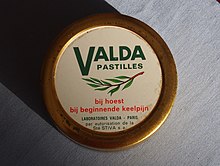Throat lozenge



Athroat lozenge(also known as acough drop,sore throat sweet,troche,cachou,pastilleorcough sweet) is a small, typically medicated tablet intended to be dissolved slowly in the mouth to temporarily stop coughs, lubricate, and soothe irritated tissues of thethroat(usually due to asore throatorstrep throat), possibly from thecommon coldorinfluenza.Cough tablets have taken the namelozenge,based on their original shape, a diamond.
Ingredients[edit]
Lozenges may containbenzocaine,ananaesthetic,oreucalyptus oil.Non-menthol throat lozenges generally use eitherzinc gluconate glycineorpectinas anoral demulcent.Several brands of throat lozenges containdextromethorphan.
Other varieties such asHallscontainmenthol,peppermint oiland/orspearmintas theiractive ingredient(s).Honeylozenges are also available.
The purpose of the throat lozenge is to calm the irritation that may be felt in the throat while swallowing, breathing, or even drinking certain fluids. However, one study found that excessive use of menthol cough drops can prolong coughs rather than relieve them.[1]
History[edit]

Candies to soothe the throat date back to 1000 BC inEgypt'sTwentieth Dynasty,when they were made from honey flavored withcitrus,herbs, and spices.[citation needed]In the 19th century, physicians discoveredmorphineandheroin,which suppress coughing at its source—the brain. Popular formulations of that era includedSmith BrothersCough Drops, first advertised in 1852, andLuden's,created in 1879. Concern over the risk ofopioid dependenceled to the development of alternative medications.[2]
Brands[edit]
- Anta
- Cēpacol
- Chloraseptic
- Fisherman's Friend
- Halls
- Jinsangzi
- Läkerol
- Lockets
- Luden's
- Mynthon
- Negro
- Nin Jiom
- Pine Bros.
- Ricola
- Robitussin
- Smith Brothers
- Strepsils
- Sucrets
- Ülker
- Takabb Anti-Cough Pill
- Throzz
- Troketts
- Tunes
- Tyrozets (now discontinued)
- Vicks
- Strep-Drops
- Victory V
- Vigroids
- Zubes (now discontinued)
See also[edit]
References[edit]
- ^Johnson, Danika; Robert Mead; Korey Kennelty; David Hahn (March 2018)."Menthol Cough Drops: Cause for Concern?".Journal of the American Board of Family Medicine.31(2): 183–191.doi:10.3122/jabfm.2018.02.170363.PMID29535234.S2CID3825988.Retrieved19 December2022.
- ^Panati, Charles (1989).Panati's Extraordinary Origins of Everyday Things.New York: Harper & Row. pp.258–260.ISBN978-0060964191.
External links[edit]
- Ingredients of a throat lozenge,Health Canada






